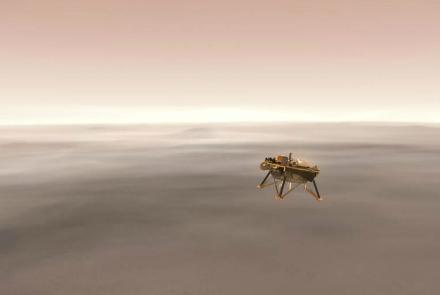NASA's Mars InSight will make history next week when it touches down on the Red Planet for the start of a two year mission that will help scientists understand the formation and early evolution of all rocky plantes, including Earth.
The touch down is scheduled to happen at approximately 1.30am Kabul time next Wednesday and viewers around the world will be able to witness the moment via NASA’s website and social media platforms.
In addition to InSight, another craft, Mars Cube One (MarCO) is flying separately to the Red Planet. This will test a new kind of data relay from another planet for the first time, though InSight’s success is not dependent on MarCO.
According to NASA, landing on Mars is difficult and only about 40 percent of the missions ever sent to Mars -- by any space agency -- have been successful.
NASA states the US is the only nation whose missions have survived a Mars landing. The thin atmosphere -- just one percent of Earth’s -- means that there’s little friction to slow down a spacecraft.
Despite this, NASA has had a long and successful track record regarding Mars missions. Since 1965, it has flown by, orbited, landed on and roved across the surface of the Red Planet.
In 2008, NASA’s Jet Propulsion Laboratory successfully landed the Phoenix spacecraft near Mars’ North Pole.
NASA said InSight is based on the Phoenix spacecraft and despite tweaks to the heat shield and parachute, the overall landing design is still very much the same.
The agency said after separating from a cruise stage, an aeroshell will descend through the atmosphere before a parachute and retrorockets slow the spacecraft down; suspended legs will absorb some shock from touchdown.
InSight’s team hopes that by studying the deep interior of Mars, scientists can learn how other rocky worlds, including Earth and the Moon, formed.
NASA stated that only one rocky planet has so far been studied in detail – Earth.
They said that by comparing Earth’s interior to that of Mars, InSight’s team members hope to better understand our solar system.
Meanwhile, two mini-spacecraft called Mars Cube One, or MarCO, have been flying on their own path to Mars behind InSight as a separate NASA experiment. MarCO is the first deep space mission for CubeSats, a class of briefcase-sized spacecraft that rely on miniaturized technology.
If the MarCOs make it to Mars, they will attempt to relay data from InSight as it enters the Martian atmosphere and lands. If successful, this could represent a new kind of communication capability to Earth.
Launched on May 5, InSight marks NASA's first Mars landing since the Curiosity rover in 2012. The landing will kick off a two-year mission in which InSight will become the first spacecraft to study Mars' deep interior.
InSight and MarCO flight controllers will monitor the spacecraft's entry, descent and landing from mission control at NASA’s Jet Propulsion Laboratory in Pasadena, California, where all landing events will take place.
Popular Science meanwhile reported that there is a lot on the Martian surface that is of interest to scientists, but little is known about what is happening on the inside – and that the makeup of the core is unknown or how geologically active Mars might be.
In order to understand these mysteries, Scientists have to look below the surface and that's InSight's specialty.
According to Popular Science, the lander will however first have to survive the “seven minutes of terror” during atmospheric entry, descent, and landing.
“We’re really excited,” says InSight Project Manager Tom Hoffman. “There’s nothing as exciting as landing on Mars. So far we are in good shape. We’ve basically done everything we can to be ready.”


